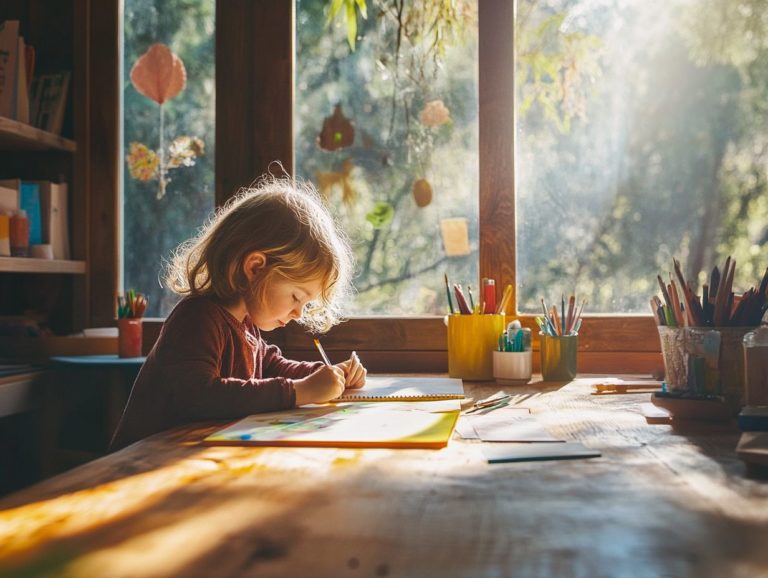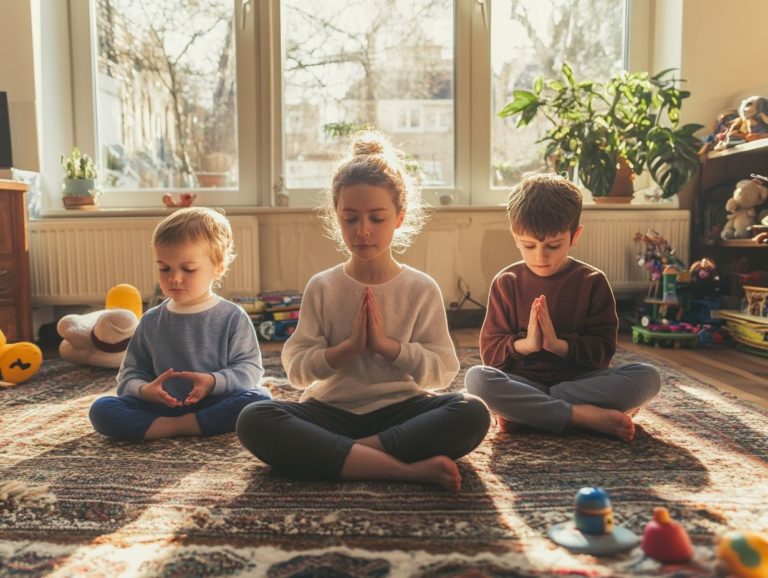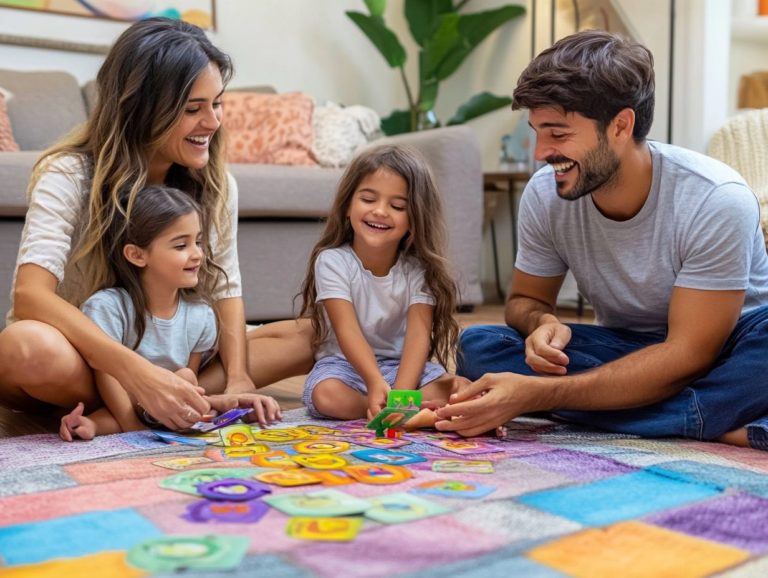Creating a Family Mindfulness Routine
In today s fast-paced world, it s all too easy for families to get swept up in the relentless hustle and bustle of daily life, leaving little time for meaningful connection and reflection. Start your journey towards a more connected and harmonious family life today!
Mindfulness emerges as a potent antidote, fostering awareness and presence within the family unit, helping to manage sensory overload and encourage emotional regulation.
This article delves into the essence of mindfulness, highlighting its significance for families and unveiling the myriad benefits of establishing a family mindfulness routine, including stress reduction and enhanced emotional intelligence.
You ll find practical steps to create this routine, engaging activities to incorporate, including mindful breathing, mindful eating, and sensory exploration, and insightful tips for nurturing mindfulness in children and managing the digital world.
Embrace the journey toward a more harmonious family life!
Contents
- Key Takeaways:
- What Is Mindfulness?
- Why Is Mindfulness Important for Families?
- How to Create a Family Mindfulness Routine?
- What Are Some Mindfulness Activities for Families?
- How to Encourage Mindfulness in Children?
- Tips for Maintaining a Family Mindfulness Routine
- Frequently Asked Questions
- Discover the Power of a Family Mindfulness Routine!
- Why is it important to have a family mindfulness routine?
- How do I create a family mindfulness routine?
- What are some activities that can be included in a family mindfulness routine?
- How long should a family mindfulness routine last?
- What are some tips for making a family mindfulness routine a success?
Key Takeaways:

- Mindfulness is the practice of paying attention to what s happening right now.
- A family mindfulness routine can improve communication, reduce stress, and create a deeper connection within the family.
- Choose a time and place, set goals and intentions, involve every family member, and incorporate activities like breathing exercises, mindful listening, sound exploration, and gratitude practice to create a successful family mindfulness routine.
What Is Mindfulness?
Mindfulness is the practice of paying attention to what s happening right now. It fosters a deeper connection to your emotional intelligence, enhances self-regulation, and sharpens your awareness of the present moment.
This practice invites your family to explore and understand your emotions better while promoting stress reduction through mindful breathing, mindful observation, and careful observation.
Why Is Mindfulness Important for Families?
Mindfulness plays a crucial role for families, as it nurtures emotional intelligence, enhances communication, and fosters healthier relationships by providing a calming environment. By equipping each family member with essential tools for emotional regulation and resilience, mindfulness gives the power to you all to navigate life’s challenges with greater ease.
Engaging in mindful activities and mindfulness exercises together allows you to cultivate an atmosphere of compassion and understanding, ultimately enhancing your collective ability to manage stress and improve overall well-being.
What Are the Benefits of a Family Mindfulness Routine?
Establishing a family mindfulness routine brings a wealth of benefits, enhancing your emotional intelligence, reducing stress, and strengthening connections among family members through various mindfulness practices.
It creates a compassionate and supportive environment that fosters emotional regulation and overall well-being. By engaging in mindfulness exercises together, your family can cultivate a shared awareness that enriches relationships and nurtures a deep sense of gratitude for one another s presence.
These routines can encompass activities like group meditation, mindful walks in nature, or even simple breathing exercises before meals all of which play a significant role in fostering understanding and empathy among family members. For example, participating in mindful discussions where everyone has an opportunity to share their thoughts without interruption encourages active listening and respect for diverse perspectives.
When your family practices compassion through acts of kindness, such as writing thank-you notes or volunteering together, you reinforce the emotional bonds that promote resilience and mutual support. Ultimately, a consistent mindfulness routine can lead to improved focus during daily interactions, making it easier for your family to navigate challenges together.
How to Create a Family Mindfulness Routine?
Creating a family mindfulness routine can be an exciting journey that brings everyone together! It requires a thoughtful approach that invites everyone to engage, cultivating a nurturing environment for connection, emotional growth, and the enhancement of vital emotional intelligence, self-regulation, and regulation skills.
To embark on this journey, start by selecting an ideal time and space for mindfulness activities. Ensure it aligns with the schedules and preferences of all family members and creates a mindful space.
Next, articulate clear goals and intentions that resonate with everyone, fostering a shared commitment.
Finally, choose practices that cater to your family’s unique dynamics, making the experience both meaningful and enjoyable for all involved, fostering a connection to the present moment.
Step 1: Choose a Time and Place
Choosing a specific time and place for your mindfulness practice is essential in establishing a consistent family routine and creating a dedicated mindful space. It sets the stage for creating a dedicated mindful space that fosters deeper connection and engagement among family members.
This intentional pause signals to everyone that it s time to focus on being present and aware, cultivating an environment that is perfect for mindfulness.
Selecting the right time can make all the difference; think about moments when everyone is generally calm, like those serene early mornings or tranquil evenings. The space you choose should be free from distractions, perhaps a cozy corner in the living room or a peaceful outdoor area where everyone can truly relax.
Involving the whole family in this decision-making process not only gives the power to each member but also enhances their sense of belonging and commitment to the practice. By collectively choosing a routine that respects everyone s preferences, your family can create a harmonious and inviting atmosphere that encourages regular mindfulness sessions.
Step 2: Set Goals and Intentions

Setting clear goals and intentions for your family mindfulness routine allows each member to grasp the purpose behind their practice. This creates a collective commitment to enhancing emotional intelligence and personal growth.
By articulating shared aspirations, you can cultivate a deeper connection to your mindfulness activities, ensuring everyone is aligned on this meaningful journey.
For example, your family might choose to set a goal of practicing gratitude each week by sharing three things you appreciate about one another. This simple act not only encourages mindfulness but also strengthens your relationships.
These goals can be revisited and adapted as individual circumstances change, considering challenges from the past. Perhaps you ll shift from weekly gratitude sessions to monthly family reflections. By checking in regularly, your family can assess what works and what doesn t, allowing your mindfulness practice to evolve and remain relevant to each member’s needs.
This ongoing dialogue keeps your family connected and engaged in the shared journey toward emotional well-being.
Step 3: Choose Activities
Choosing a variety of mindfulness activities is essential for keeping your family members engaged and promoting emotional regulation. Different practices cater to diverse preferences and needs, ensuring that everyone finds something that resonates.
You can explore a range of options, such as mindful breathing exercises, mindful eating, and mindful observation, each offering unique opportunities to enhance awareness and strengthen emotional connections.
For instance, you might practice mindful breathing together as a simple routine at the start or end of each day, allowing everyone to focus and center themselves. Mindful eating encourages your family to truly appreciate meals by turning off distractions and savoring flavors while discussing the origins of the food on your plates.
During nature walks, mindful observation can become a delightful activity. Family members can take the time to notice the intricate details of their surroundings, fostering a sense of gratitude and connection with nature, enhancing parental resilience.
By trying out these activities, you allow your family to discover which practices resonate most deeply, creating a fun and meaningful exploration of mindfulness together, cultivating an open heart.
Step 4: Involve Everyone in the Family
Involving everyone in your family in the mindfulness routine is essential for cultivating a sense of belonging and connection. It fosters open communication and strengthens the relationships among family members. By creating an inclusive environment, you can ensure that each individual s voice is heard, making the collective practice meaningful for everyone.
To achieve this, consider engaging in mindfulness strategies that cater to the diverse needs and preferences of your family. Start by holding a family meeting to discuss what mindfulness means to each person and explore various activities, such as guided meditation, mindful walking, or even simple breathing exercises. Encourage everyone to share their ideas and be open to trying new practices that resonate with each individual.
Flexibility is crucial here; think about varying the duration and setting of your mindfulness sessions. Whether it s a tranquil space at home or a beautiful outdoor setting, find what appeals to your family.
This collaborative approach not only enhances participation but also creates a supportive environment, ensuring that mindfulness becomes a valued family ritual rather than a chore, promoting social-emotional development.
What Are Some Mindfulness Activities for Families?
Mindfulness activities for families can include a diverse array of engaging practices that foster emotional awareness, connection, and gratitude. These activities enable you and your loved ones to cultivate a shared experience grounded in mindfulness, from mindful eating to trauma-informed care.
By integrating activities such as mindful breathing, mindful eating, and gratitude exercises, you can enhance your emotional intelligence and strengthen your relationships, creating a deeper bond within your family unit.
1. Mindful Breathing Exercises
Mindful breathing exercises serve as a cornerstone of mindfulness practices. They enable you and your family to focus on your breath as a powerful tool for stress reduction and emotional regulation. Engaging in these exercises together can foster a calming environment that enhances relaxation and deepens connections among family members.
By dedicating just a few minutes each day to mindful breathing, you can cultivate a sense of awareness and presence that offers long-lasting benefits. Simple techniques like the ‘5-5-5 method’, where you inhale for five seconds, hold for five seconds, and exhale for five seconds, make for an excellent starting point.
Consider incorporating visualization techniques, such as imagining a serene setting while you breathe. This can enrich the experience and make it enjoyable for both children and adults. Engage the family in a playful game using colorful breathing balls that expand and contract with each breath, creating a fun yet mindful atmosphere.
Regularly practicing these exercises together not only helps in managing stress but also supports emotional resilience and strengthens family bonds.
2. Mindful Movement Activities
Mindful movement activities present a remarkable opportunity for you and your family to engage physically while cultivating a deeper awareness and connection to your bodies and surroundings. This practice enhances emotional and physical well-being and fosters a sense of unity among family members. Activities like yoga, dancing, or even simple stretching can serve as pathways to relaxation and togetherness.
These practices encourage collaborative effort within the family, allowing individuals to express their feelings through movement. For example, family yoga sessions create a serene space where everyone learns to breathe and move in harmony, promoting emotional regulation. Dancing be it freestyle or structured styles like Zumba invites joy and spontaneity, enabling you to connect through rhythm.
Mindful walking in nature inspires an appreciation for the environment and sparks meaningful conversations that deepen your family bonds. As you explore diverse movements together, you ll uncover what resonates best with your family, enriching your emotional bonds and overall well-being.
How to Encourage Mindfulness in Children?
Encouraging mindfulness in children is vital for nurturing emotional intelligence, resilience, and effective communication skills. This powerful practice equips them with valuable tools to navigate their feelings and the complexities of the world around them.
By seamlessly integrating mindfulness into their daily routines, you can help your children cultivate a heightened awareness of their emotions, fostering both personal growth and emotional regulation.
1. Set the Standard: Be the Example Your Children Need
Leading by example is one of the most powerful ways to encourage mindfulness in your children, as they often reflect the behaviors and attitudes of their caregivers. By practicing mindfulness yourself, you demonstrate emotional awareness and self-regulation, providing a living example of its benefits.
This modeling can take many forms. Incorporate brief meditation sessions into your daily routine, engage in mindful breathing exercises, or be present during family meals by setting aside distractions like phones and televisions. Share your own mindfulness experiences, discussing how it helps you manage stress or enhances your overall well-being.
When your children witness you actively prioritizing mindfulness, it creates an environment where they feel inspired to embrace these practices. It also fosters an understanding of the importance of being present and aware in their own lives. Ultimately, this shared journey toward mindfulness lays a strong foundation for them to develop emotional intelligence and resilience as they grow.
3. Mindful Eating

Mindful eating invites you and your family to slow down and truly appreciate your food. This practice enhances your enjoyment of meals and promotes healthier eating habits while strengthening emotional connections during family gatherings.
Gathering around the table without distractions allows for meaningful conversations, sharing stories, and savoring each bite. Transform mealtime into a cherished ritual by turning off screens, allowing everyone to focus on both the food and one another. Encourage each family member to express their thoughts on the flavors and textures to create a richer appreciation for the meal.
Taking a moment before eating to express gratitude for the food helps connect with each other and fosters positive attitudes toward healthy eating choices.
4. Gratitude Practice
Engaging in a gratitude practice as a family can profoundly enhance your emotional awareness and connection. By expressing gratitude for one another, you and your family can elevate your emotional intelligence and cultivate stronger, more compassionate relationships.
Consider simple activities like maintaining gratitude journals, where each family member records what they are thankful for. This encourages reflection and mindfulness, allowing everyone to pause and appreciate the little things.
Set aside dedicated time during family meals or gatherings to share moments of appreciation. By embracing these practices, your family can boost emotional well-being, reducing stress and anxiety while amplifying feelings of happiness and belonging.
Over time, cultivating gratitude can reshape your family dynamics, making empathy and understanding essential to your interactions. This shift ultimately gives the power to everyone to navigate life with a more optimistic perspective.
2. Make it Fun and Engaging
Making mindfulness enjoyable for children is essential for nurturing their interest and encouraging participation in mindfulness practices. This approach allows them to explore their emotions and awareness in a delightful way. You can transform mindfulness into an exciting adventure for young minds by incorporating games, stories, and creative activities.
One effective strategy to ignite their interest is through mindful storytelling, where children create their own tales while focusing on their feelings and thoughts as characters. Another captivating activity is the Mindful Scavenger Hunt, where children search for objects that embody different emotions or sensory experiences found in their environment.
Engaging in creative projects, such as crafting emotion masks, sparks lively discussions about feelings, helping kids recognize and articulate their emotions in a playful setting. By intertwining artistic expression with mindfulness practices, children can develop essential skills like focus and self-awareness all while having a fantastic time.
3. Incorporate Mindfulness into Daily Activities
Incorporating mindfulness into daily activities can be an incredibly effective strategy for helping children develop essential mindfulness skills. Simple adjustments like being fully present during meals or engaging in mindful listening during conversations can deepen their connection to the present moment.
You can introduce mindfulness through engaging activities like mindful walking, where your children focus on the sensations of each step, or through arts and crafts that encourage both creative expression and attentiveness. Reading together can also transform into a mindful practice. By pausing to discuss the emotions tied to the story, you help your kids articulate their feelings more clearly.
By consistently utilizing these practices, you enhance their ability to stay grounded in the moment and cultivate emotional awareness. This equips them to navigate their feelings and reactions more effectively as they grow.
4. Provide Positive Reinforcement

Providing positive reinforcement for practicing mindfulness can significantly encourage children to embrace these techniques, fostering a sense of accomplishment and motivation. Celebrate their efforts in developing emotional intelligence. This creates a supportive environment for mindfulness skills.
This support can manifest in various ways, whether through verbal praise, small rewards, or simply engaging in mindfulness activities together as a family. Consider creating a mindfulness milestone chart where your children can visually track their practice and mark off achievements, reinforcing their journey. Celebrating each small step like completing a meditation session or practicing deep breathing during a stressful moment validates their experiences and encourages continued growth.
Discuss how mindfulness impacts their lives to help your children recognize the value of their efforts, making them more inclined to incorporate these healthy practices into their daily routines. Consider using a feelings chart to help them articulate their emotional awareness.
Tips for Maintaining a Family Mindfulness Routine
Maintaining a family mindfulness routine can significantly enhance emotional intelligence and self-regulation among children and parents.
Maintaining a family mindfulness routine demands both commitment and consistency. This practice encourages ongoing emotional regulation and strengthens connections among family members, especially in the face of life s challenges and stress.
By thoughtfully implementing practical strategies and creating a supportive environment, you can establish a lasting mindfulness practice that significantly enhances your family s emotional intelligence and overall well-being. Including activities like mindful observation, gratitude exercises, and sound exploration can create a calming environment for everyone.
Frequently Asked Questions
Discover the Power of a Family Mindfulness Routine!
A family mindfulness routine is crucial for developing social-emotional skills.
It involves activities that help everyone focus on the present moment and understand their feelings. These practices nurture emotional expression and strengthen family bonds.
Why is it important to have a family mindfulness routine?
Understanding the significance of mindfulness practices can help families manage sensory overload.
A family mindfulness routine helps improve communication and strengthen relationships. It also promotes overall well-being, reduces stress, and enhances mood and concentration.
Techniques like mindful eating and creating peaceful spaces are particularly beneficial for stress reduction.
How do I create a family mindfulness routine?
Crafting a mindful space at home is an excellent first step.
Start by setting aside specific times each day or week for mindfulness practice.
Choose activities suitable for all family members, like guided meditations, mindful walks, or gratitude exercises. Involve everyone in the planning process to ensure inclusion and motivation.
Consider adding elements of nature and songs to make activities more engaging.
What are some activities that can be included in a family mindfulness routine?
Incorporating a digital detox will supercharge your mindfulness experience.
Activities suitable for a family mindfulness routine include deep breathing exercises, mindful coloring, body scan meditations, journaling, and mindful eating.
Engaging in mindful listening and observation is also beneficial.
Choose enjoyable activities that can easily fit into daily life.
How long should a family mindfulness routine last?
Incorporating intentional pauses can be beneficial.
A family mindfulness routine can last anywhere from 10 minutes to an hour, depending on the age and attention span of family members.
Finding a balance between shorter and longer activities is key to keeping everyone engaged.
Practicing body awareness and connecting through playfulness can enhance the routine’s enjoyment.
What are some tips for making a family mindfulness routine a success?
Understanding mindfulness benefits for both children and parents can drive success.
To succeed, be consistent yet flexible. Set a regular time for practice, but be open to adjustments.
Encourage patience and understanding, while promoting open communication and active participation from everyone.
Most importantly, have fun and enjoy the process together!
Creating a conducive environment and focusing on emotional regulation will also contribute to success.





